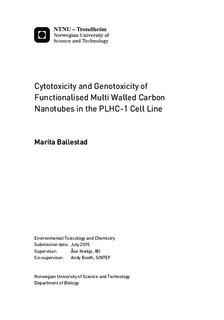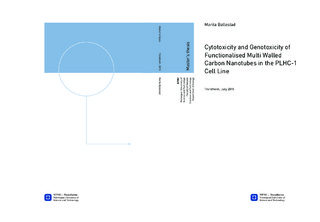| dc.description.abstract | The field of nanotechnology is rapidly expanding in all sectors of society due to its increasingly large number of applications. This field deals with materials at the nanoscale, defined as having at least one dimension below 100 nm. The rapid increase in production of nanomaterials is a cause of concern, as their exposure to the environment may increase rapidly, in combination with lacking knowledge of exposure effects. Carbon nanotubes (CNTs) are one type of nanomaterial that have a wide range of properties, which make them very useful in a variety of products. Their applications range from transporters of drugs to superconductors. There exist single-walled, double-walled and multi-walled CNTs (MWCNT) which are often functionalised by adding functional groups on the CNT surface. This enhances the CNT s solubility and applicability in many circumstances, but may also alter its toxicity. Due to the continuously increasing production of CNTs it is inevitable that these compounds will be released to the environment, and the aquatic environment is often a sink for such pollutants.
In the current study, the aim was to investigate if differently functionalised MWCNTs with identical size had the potential to induce cytotoxic and genotoxic damage in vitro in liver cells of the fish Poeciliopsis lucida (PLHC-1); and if this potential damage differed with the type of functionalisation. Four MWCNTs were assessed, with different functionalisations as follows: COOH, OH, NH2 and one pristine (MWCNT-P). Cytotoxicity was assessed by the MTT-assay after 48 hours exposure to each MWCNT in the range 0.5-2048 µg/mL. Genotoxicity was assessed after 48 hours exposure to 4 and 64 µg/mL of each MWCNT with the DNA double strand break (DSB) assay.
The results demonstrated that each of the four MWCNTs tested induced some cytotoxicity, but at relatively high concentrations. MWCNT-COOH appeared to be slightly more cytotoxic than the other CNTs, whereas MWCNT-NH2 appeared to be the least cytotoxic. MWCNT-NH2 was not particularly cytotoxic until a concentration of ~100 µg/mL was reached. The difference in cytotoxicity was hypothesised to be due to degree of dispersability and therefore bioavailability of the CNT, which was related to surface functionalisation of the CNT. However, CNT adsorption of formazan could have influenced the results, causing false positive results for cytotoxicity.
Results obtained in the genotoxicity assay were inconsistent, mostly due to problems with cell lysis. The initial assessment of the fraction of DNA that migrated into the gel (DNA-FTM) relative to the amount loaded, did not indicate any apparent differences between MWCNT groups or within each group. However, investigation of median molecular lengths (MMLs) of the damaged DNA indicated that MWCNT-OH and MWCNT-NH2 was genotoxic at the low (4 µg/mL) and high (64 µg/mL) exposures respectively. Due to inconsistencies in genotoxic data it was difficult to draw any conclusions on the genotoxic potential of any of the MWCNTs.
The results from this study indicate that the risk of cytotoxic effects to PLHC-1 cells is relatively small even at high concentrations (mg/L). Since current environmental concentrations are much lower (ng-µg/L), cytotoxic effects in liver of adult fish in the environment is relatively unlikely. However, the current study was conducted in vitro, therefore it was not possible to study toxicokinetics in relation to CNTs. Moreover, it could not be determined with accuracy at what concentrations genotoxic effects may occur. It is also important to consider that CNTs may interact with other toxic substances (such as pesticides) and enhance their toxic effects. Future evaluations of CNT toxicity would benefit from keeping a higher level of standardisation, as well as determining CNT interactions with assay/serum components. | |

